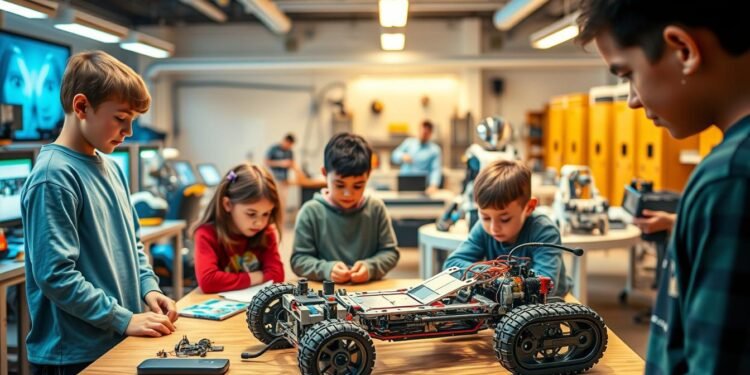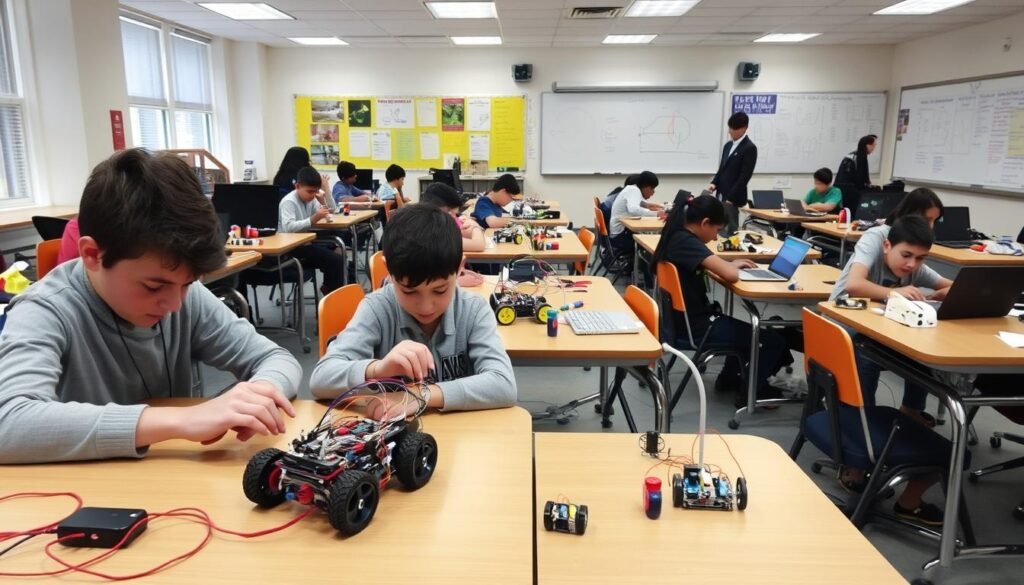Have you ever wondered how learning about robotics can shape the future of young minds? Robotics is more than just a technical field; it’s a gateway to developing critical thinking, creativity, and problem-solving skills. For learners of all levels, hands-on experiences in this area can be transformative.
From simple, unplugged tasks to advanced programmable systems, robotics offers a structured way to build computational thinking. It combines STEM disciplines with real-world applications, making it a valuable skill for future careers. Whether you’re a beginner or an advanced learner, there’s always something new to explore.
Key Takeaways
- Robotics blends STEM skills with creativity for a well-rounded learning experience.
- Hands-on learning helps develop critical thinking and problem-solving abilities.
- Progress from basic tasks to advanced programmable systems.
- Real-world applications make robotics relevant for future careers.
- Structured learning builds computational thinking effectively.
Introduction to Robotics Activities for Students
Exploring robotics opens doors to innovation and hands-on learning. It serves as a gateway to STEM literacy, blending science, technology, engineering, and math into one engaging field. Through robotics, learners develop critical thinking and problem-solving skills that are essential for future success.
Robotics also fosters curiosity and collaboration. Families can bond over building and programming projects, making it a shared experience. This approach aligns with the “I’m the Chef Too!” philosophy, where everyone contributes to the process. It’s not just about technology; it’s about teamwork and creativity.
For those looking to reduce screen time, robotics offers screen-free alternatives. Tactile learning through physical kits and unplugged activities enhances motor skills and spatial awareness. These methods make robotics accessible to all, regardless of technical background.
National Robotics Week is a key event that highlights the importance of robotics in education. It provides resources for educators and students, making STEM learning more inclusive. This annual celebration inspires the next generation of innovators.
Robotics connects directly to real-world problem-solving. From designing smart devices to exploring AI, it prepares learners for future tech trends. By engaging in robotics, students gain practical skills that are relevant in today’s fast-paced world.
What is STEM Robotics?
STEM robotics combines multiple disciplines to solve real-world challenges. It integrates science, technology, engineering design, and math into one cohesive field. This approach helps learners understand how these areas work together in practical applications.
In STEM robotics, science explores concepts like motion and biomimicry. Technology focuses on sensors and programming, while engineering design emphasizes structural principles. Math plays a role in sequencing and algorithms, making it a truly interdisciplinary experience.
This field is similar to hands-on “edutainment” approaches, such as culinary STEM kits. Both methods blend creativity with technical skills, making learning engaging and effective. STEM robotics encourages iterative processes—build, test, and refine—to achieve the best results.
Applications of STEM robotics are vast, from designing Mars rovers to creating medical robots. These projects highlight the importance of engineering design and computer science in solving complex problems. They also inspire learners to think critically and innovate.
STEM robotics aligns with the mission of blending creativity with technical expertise. It prepares learners for future challenges by fostering problem-solving skills and a deep understanding of interdisciplinary concepts. This makes it a valuable tool for education and innovation.
Why Engage Students in Robotics?
Why should young learners dive into the world of robotics? It’s more than just a technical skill—it’s a way to build critical thinking and problem-solving abilities. By engaging in robotics, they learn to approach challenges methodically and creatively.
Robotics also helps develop coding literacy. Through block-based programming and algorithm design, learners grasp the basics of computer science. These skills are essential in today’s tech-driven world.
Open-ended projects, like designing custom robots, encourage creativity. They allow learners to experiment and innovate, turning ideas into tangible solutions. This hands-on approach makes learning both fun and impactful.
Resilience is another key benefit. Tasks like navigating a maze teach the value of trial and error. These experiences prepare young minds for real-world challenges, fostering perseverance and adaptability.
Finally, robotics prepares learners for future careers. As automation and IoT technologies grow, these skills become increasingly valuable. By starting early, students gain a competitive edge in a rapidly evolving job market.
Getting Started with Robotics: A Phased Approach
Starting with robotics can feel overwhelming, but breaking it into phases makes it manageable. A phased approach ensures steady progress, from basic logic to advanced programming. This method aligns with age and skill level, making learning accessible and effective.
In Phase 1, focus on unplugged activities. These tasks introduce logic and problem-solving without screens. For example, human robot games teach sequencing and commands. This step builds a strong foundation for future learning.
Phase 2 transitions to low-tech tools. Tactile devices like Code-a-pillar and Ozobot make learning hands-on and engaging. These tools help learners understand basic coding concepts in a fun, interactive way.
Finally, Phase 3 introduces block-based coding. Platforms like Sphero and LEGO kits allow learners to program robots with ease. This step bridges the gap between beginner and intermediate levels, preparing them for more complex projects.
Guided learning paths, such as subscription kits, can enhance this process. They provide structured resources and support, making each step clearer and more achievable. By following this phased approach, beginners can confidently advance their skills in robotics.
Unplugged Robotics Activities
Unplugged robotics offers a screen-free way to explore creativity and logic. These hands-on tasks focus on building problem-solving skills without relying on technology. They are perfect for learners who enjoy tactile experiences and imaginative challenges.
Human Robot Game
The Human Robot Game teaches algorithmic thinking through precise command sequencing. One learner acts as the “robot,” while another provides step-by-step instructions. This activity helps develop debugging skills and spatial reasoning.
For example, navigating a maze requires clear and logical commands. It’s a fun way to understand how robots process information. This game also encourages teamwork and communication.
Paper Plate Robotics
Paper Plate Robotics uses craft materials like plates, brads, and pipe cleaners to create moving parts. This activity focuses on design and creativity, allowing learners to build simple machines. It’s an excellent way to explore engineering concepts in a hands-on way.
Learners can also design robot characters with unique functions. This adds a storytelling element, making the activity even more engaging. It’s a great way to connect creativity with technical skills.
These unplugged activities align with the step-by-step processes of culinary STEM kits. Both emphasize following instructions and experimenting with design. They provide a foundation for more advanced projects in robotics.
Low-Tech Robots for Beginners
Low-tech robots provide an excellent entry point for beginners to explore coding and engineering concepts. These tools are designed to be simple yet effective, making them ideal for those new to the field. They focus on hands-on learning, offering tactile feedback and screen-free operation.
Code & Go Robot Mouse
The Code & Go Robot Mouse is a fantastic tool for teaching path planning. Users program routes using directional buttons to guide the mouse to its cheese. This activity introduces basic coding principles in a fun and interactive way.
It’s a great way to understand how robots navigate obstacles. The tactile nature of this tool makes it engaging for beginners. It also parallels real-world applications, like autonomous delivery robots.
Code-a-pillar
Code-a-pillar is perfect for preschoolers. It uses segmented commands to teach movement sequences. Kids arrange the segments to create different paths, fostering early engineering and problem-solving skills.
This tool emphasizes precision, much like the “I’m the Chef Too!” approach to baking. Both activities require careful planning and execution. Code-a-pillar’s screen-free design makes it accessible and enjoyable for young learners.
These low-tech robots are ideal for beginners. They simplify complex concepts, making tasks approachable and fun. By starting with these tools, learners build a strong foundation for more advanced projects.
Programmable Robots for Intermediate Students
Intermediate robotics projects bridge the gap between basic and advanced skills. These tools introduce learners to programming and engineering design, preparing them for more complex tasks. Programmable robots like Sphero and LEGO MINDSTORMS offer hands-on experiences that build confidence and creativity.
Sphero Robots
Sphero robots are perfect for exploring programming through block-based coding. Users can control paths, speeds, and LED colors using intuitive apps. For those ready to advance, JavaScript options are available, offering a deeper dive into coding concepts.
These robots are ideal for collaborative projects, such as package-delivery simulations. They encourage teamwork and problem-solving, making learning both fun and impactful. Sphero’s versatility makes it a favorite among intermediate learners.
LEGO Robotics
LEGO MINDSTORMS combines building and programming in one engaging platform. Learners construct robots with motors and sensors, then solve curriculum-based challenges. This approach emphasizes engineering design and critical thinking.
LEGO Robotics also connects to STEM competitions like FIRST LEGO League. These events inspire creativity and innovation, allowing learners to showcase their skills. Customizing robot behaviors and appearances adds a personal touch to each project.
Both Sphero and LEGO Robotics prepare learners for advanced tasks. They foster creativity, collaboration, and technical expertise, making them essential tools for intermediate students.
Advanced Robotics Projects
Taking robotics to the next level opens up endless possibilities for innovation. Advanced projects dive deeper into computer science and engineering, offering hands-on experiences with cutting-edge tools. These tasks prepare learners for real-world challenges in automation and IoT.
Micro:bit Projects
Micro:bit is a versatile tool for advanced learners. It teaches Python programming, enabling users to create robotic cars or environmental sensors. These projects focus on design and functionality, making them ideal for exploring IoT applications.
For example, building a weather station with Micro:bit combines engineering and computer science. It’s a practical way to understand data collection and analysis. Open-source communities offer endless project ideas, from automated plant waterers to smart home devices.
Arduino-based Robots
Arduino takes robotics to another level with C++ programming. Users can build custom robots using servo motors and ultrasonic sensors. These projects emphasize design and precision, making them perfect for advanced learners.
Arduino-based robots are widely used in mechatronics and AI. They offer a glimpse into career pathways in automation and robotics. Platforms like Science Buddies provide over 25 lesson plans, making it easy to get started.
Both Micro:bit and Arduino prepare learners for future challenges. They foster creativity, technical expertise, and problem-solving skills, making them essential tools for advanced robotics.
Robotics in the Classroom
Bringing robotics into the classroom transforms traditional teaching methods. It provides a hands-on way to explore STEM concepts while fostering creativity and problem-solving skills. By integrating robotics into subjects like math and physics, learners can see real-world applications of angles, force, and motion.
Group projects are an excellent way to teach teamwork and division of labor. Students can collaborate to design and program robots, learning how to communicate effectively and share responsibilities. These projects also encourage critical thinking as they solve challenges together.
Free resources like Science Buddies’ coding tutorials make it easy to get started. Platforms like iRobot Education and STEM in the Middle offer lesson plans tailored to different grade levels. These tools help educators bring robotics into their classroom without overwhelming their curriculum.
National Robotics Week provides additional opportunities for teaching robotics. Classroom challenges during this event inspire innovation and creativity. It’s a great way to engage students and highlight the importance of STEM education.
For those on a budget, DIY projects like bristlebots are a fun and affordable option. These simple robots can be built with everyday materials, making them accessible to all. They’re a creative way to introduce basic engineering and programming concepts.
By incorporating robotics into the classroom, educators can prepare students for future technological advancements. It’s a practical and engaging approach to modern education.
Robotics Competitions and Challenges
Robotics competitions inspire innovation and teamwork among young learners. Events like FIRST LEGO League and VEX IQ encourage participants to tackle real-world challenges. These competitions focus on themes such as climate change solutions, fostering creativity and problem-solving skills.
Preparation is key to success in these events. Teams often engage in prototyping and iterative testing to refine their designs. This process teaches valuable lessons in persistence and adaptability, skills that are essential for future STEM careers.
Beyond the competition, these events open doors to college scholarships and industry partnerships. Many participants gain recognition for their innovative projects, paving the way for academic and professional opportunities. Success stories from student teams highlight the transformative impact of these experiences.
For example, a team from California developed a robot to clean ocean debris, earning accolades at a national level. Such achievements demonstrate how robotics competitions can inspire meaningful change. They also showcase the potential of young minds to address global challenges.
Engaging in these events not only builds technical expertise but also fosters collaboration and leadership. Whether designing a robot or solving complex problems, participants gain skills that extend far beyond the competition arena. Robotics competitions are a powerful way to prepare students for the future.
Resources for Robotics Education
Accessing the right tools and materials can make learning about robotics both fun and effective. Whether you’re a parent, educator, or learner, having the right resources is key to success. From coding platforms to hands-on kits, there’s something for everyone.
For coding, platforms like Scratch and Tynker are excellent starting points. They use block-based programming to teach the basics of computer science in an engaging way. These tools are perfect for beginners and intermediate learners alike.
Hardware kits like LEGO SPIKE Prime and Ozobot Evo bring robotics to life. These kits combine building and programming, making them ideal for hands-on education. They’re designed to spark creativity and problem-solving skills.
Free lesson plans from the National Robotics Week hub are a great way to get started. These resources cover a range of topics, from basic concepts to advanced projects. They’re tailored for different age groups and skill levels.
Books like “The Wild Robot” add a storytelling element to robotics education. They inspire curiosity and creativity, making learning more enjoyable. For hybrid projects, kits like “I’m the Chef Too!” blend STEM with art, offering a unique approach to hands-on learning.
With these resources, anyone can dive into the world of robotics. They provide a structured way to explore computer science and engineering, making learning accessible and fun.
Tips for Parents and Educators
Supporting young learners in robotics requires practical strategies for parents and educators. Starting with simple, hands-on activities can make the learning process more engaging and less intimidating. Unplugged tasks, like building with craft materials, are a great way to introduce basic concepts without overwhelming beginners.
Encouraging mistakes as part of the teaching process is essential. Debugging and problem-solving are core skills in robotics, and learners should feel comfortable experimenting and iterating. This approach fosters resilience and critical thinking, which are valuable in all areas of life.
Balancing screen time is another key tip. While programming is a major part of robotics, tactile learning through physical kits can reduce dependency on screens. This balance helps maintain focus and enhances motor skills.
Collaborating with local makerspaces or libraries can provide additional resources and workshops. These community spaces often offer tools and expertise that can enrich the learning experience. They also provide opportunities for group projects and peer collaboration.
Finally, subscribing to monthly robotics kits can offer a structured plan for continuous learning. These kits often come with step-by-step instructions and materials, making it easier for parents and educators to guide learners. With these tips, you can create a supportive environment that nurtures curiosity and innovation in robotics.
Real-World Applications of Robotics
From hospitals to outer space, robotics is reshaping our world. These innovations are not just theoretical—they’re improving life in tangible ways. Whether it’s precision surgery or exploring distant planets, robotics is at the forefront of modern advancements.
In medicine, the da Vinci Surgical System has revolutionized procedures. This robotic tool allows surgeons to perform complex operations with unmatched precision. It’s a prime example of how engineering and design can enhance healthcare outcomes.
Agriculture is also benefiting from robotics. Drones equipped with sensors monitor crop health, optimizing yields and reducing waste. These tools help farmers make data-driven decisions, ensuring sustainable practices for the future.
Space exploration showcases robotics’ potential on a grand scale. The Perseverance Rover is currently gathering data on Mars, paving the way for human missions. This project highlights the intersection of engineering and cutting-edge technology.
Self-driving cars are another exciting application. These vehicles rely on advanced algorithms and sensors to navigate roads safely. They’re a glimpse into how robotics can transform transportation and improve life in urban areas.
Finally, robotics plays a key role in sustainability efforts. Automated systems are used in recycling plants to sort materials efficiently. This reduces waste and supports environmental conservation, proving that robotics can make a positive impact on life and the planet.
Future of Robotics
The future of robotics is evolving faster than ever, shaping industries and daily life. From human-robot collaboration to ethical debates, this field is poised to transform society in profound ways. As technology advances, robotics will play a key role in solving global challenges and improving efficiency.
One major trend is the integration of AI into robotics. This combination enhances capabilities, enabling robots to perform complex tasks with precision. For example, collaborative robots (cobots) are already working alongside humans in manufacturing, healthcare, and other sectors. These advancements highlight the growing importance of computer science and engineering in robotics.
However, ethical concerns remain. Issues like job displacement and data privacy are hot topics in the robotics debate. While automation can increase productivity, it also raises questions about workforce readiness. Addressing these challenges requires thoughtful policies and continuous education.
Emerging fields like swarm robotics and soft robotics are pushing boundaries. Swarm robotics mimics the behavior of natural systems, such as bees, to solve problems collectively. Soft robotics focuses on flexible materials, enabling robots to interact safely with humans. These innovations showcase the creativity and potential of engineering in robotics.
To prepare for this future, pursuing STEM degrees is essential. Fields like computer science and engineering offer the skills needed to thrive in a robotics-driven world. Lifelong learning platforms, such as Arduino Project Hub, provide resources for continuous skill development.
The future of robotics is full of opportunities and challenges. By embracing innovation and addressing ethical concerns, we can ensure that robotics benefits society as a whole. Whether you’re a student or a professional, now is the time to explore this exciting field.
Conclusion
Robotics offers a dynamic pathway for learners to grow from simple logic to complex problem-solving. Starting with unplugged tasks and advancing to programmable systems, this journey builds essential skills like critical thinking and creativity.
Engaging in robotics prepares students for future challenges. Events like National Robotics Week provide opportunities to explore this field further. These experiences foster innovation and teamwork, making learning both impactful and fun.
For those seeking interdisciplinary approaches, kits like “I’m the Chef Too!” blend creativity with technical expertise. They inspire learners to think outside the box and apply their skills in unique ways.
As technology evolves, robotics continues to shape the future. By participating in hands-on activities, students can become the innovators of tomorrow. Embrace the possibilities and let robotics guide your journey.
FAQ
What are some beginner-friendly robotics projects for kids?
Start with simple projects like the Code & Go Robot Mouse or Code-a-pillar. These teach basic coding and problem-solving skills without needing advanced tools.
How can robotics help students develop STEM skills?
Robotics integrates science, technology, engineering, and math (STEM) by encouraging hands-on learning, critical thinking, and creativity through building and programming robots.
What are unplugged robotics activities?
These are tasks that don’t require computers or devices, like the Human Robot Game or Paper Plate Robotics. They teach coding concepts and teamwork in a fun, interactive way.
Which robots are best for intermediate learners?
Sphero Robots and LEGO Robotics kits are great for students ready to explore more complex programming and engineering design processes.
What advanced robotics projects can students try?
Advanced learners can work on Micro:bit Projects or Arduino-based Robots, which involve coding, electronics, and building functional devices.
How can teachers incorporate robotics into the classroom?
Use robotics kits and lesson plans to align with curriculum goals. Focus on teamwork, problem-solving, and real-world applications to make learning engaging.
Are there robotics competitions for students?
Yes, events like FIRST Robotics and VEX Robotics offer challenges that encourage innovation, collaboration, and technical skills.
What resources are available for robotics education?
Websites like Code.org, Tinkercad, and Robo Wunderkind provide tutorials, kits, and activities tailored for different skill levels.
How can parents support their child’s interest in robotics?
Encourage hands-on learning with kits, enroll them in coding classes, and explore local robotics clubs or workshops to nurture their passion.
What are the real-world applications of robotics?
Robotics is used in industries like healthcare, manufacturing, and space exploration. Learning robotics prepares students for future careers in these fields.









